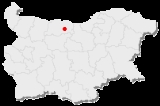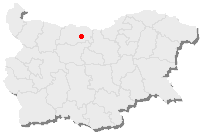
Slavyanovo
Encyclopedia

Pleven Municipality
Pleven Municipality is a municipality in Pleven Province, Northern Bulgaria. It is named after its administrative centre - the city of Pleven which is also the capital of the Province....
of the Pleven Province
Pleven Province
Pleven Province is a province located in central northern Bulgaria, bordering the Danube river, Romania and the Bulgarian provinces of Vratsa, Veliko Tarnovo and Lovech. It is divided into 11 subdivisions, called municipalities, that embrace a territory of 4,333.54 km² with a population, as...
. It lies in the Middle Danubian Plain
Danubian Plain (Bulgaria)
The Danubian Plain constitutes the northern part of Bulgaria, situated north of the Balkan Mountains and south of the Danube. Its western border is the Timok River and to the east it borders the Black Sea. The plain has an area of . It is about long and wide.The relief of the Danubian Plain is...
, to the north-northeast of Pleven. As of December 2009, it has a population of 4,422 inhabitants and the mayor is Asen Bachev. The town is located at 43°28′N 24°52′E, 114 metres above sea level.
Slavyanovo's old name is Turski Trastenik (Турски Тръстеник) and it existed in the middle of the 18th century. It was officially declared a town in 1974. Slavyanovo is a partner of German
Germany
Germany , officially the Federal Republic of Germany , is a federal parliamentary republic in Europe. The country consists of 16 states while the capital and largest city is Berlin. Germany covers an area of 357,021 km2 and has a largely temperate seasonal climate...
town Kaiserslautern
Kaiserslautern
Kaiserslautern is a city in southwest Germany, located in the Bundesland of Rhineland-Palatinate at the edge of the Palatinate forest . The historic centre dates to the 9th century. It is from Paris, from Frankfurt am Main, and from Luxembourg.Kaiserslautern is home to 99,469 people...
. The population is mainly Eastern Orthodox and there is a church, but at least in the 1930s there was also a small Protestant
Protestantism
Protestantism is one of the three major groupings within Christianity. It is a movement that began in Germany in the early 16th century as a reaction against medieval Roman Catholic doctrines and practices, especially in regards to salvation, justification, and ecclesiology.The doctrines of the...
community. Most residents are Bulgarians
Bulgarians
The Bulgarians are a South Slavic nation and ethnic group native to Bulgaria and neighbouring regions. Emigration has resulted in immigrant communities in a number of other countries.-History and ethnogenesis:...
, though the town has a growing Roma
Roma in Bulgaria
The Roma in Bulgaria are the country's second largest minority and third largest ethnic group . According to the 2001 census, there were 370,908 Roma in Bulgaria, equivalent to 4.7% of the country's total population, making Bulgaria the European country with the highest percentage of Roma.Experts'...
population.

